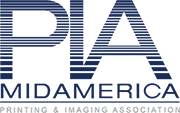
By: Brian Rutherford, PIA MidAmerica Regulatory Specialist
I have visited many printing companies since the outbreak of the current pandemic, and seen that most companies are performing basic steps to protect workers. PIA MidAmerica recently hosted an OSHA & COVID-19 webinar, conducted by myself and Joe Eudy of our Dallas office. We have both seen that requiring face coverings, social distancing, frequent disinfecting and sanitizing of contact surfaces, allowing telecommuting and other administrative controls, limiting and/or controlling visitors and vendors in the facility, encouraging proper hygiene and providing hand-washing and -sanitizing supplies and following local and state health department mandates seem to be, among other control measures, commonplace within our industry. However, I have noted many companies are not aware that, even as a Lower Risk – Caution workplace, you are required to establish a COVID-19 Preparedness and Response Plan (CPRP) as well as a team of responsible individuals to administer the program.
When you have an employee reporting either a positive test or experiencing symptoms, you are required to take several actions recommended by CDC and required by the Occupational Safety & Health Administration (OSHA.) As the vast majority of printing, packaging and publishing companies would fall into the category of “Lower Risk – Caution,” as outlined in pages 18-20 in OSHA’s Guidelines for Preparing Workplaces for COVID-19 (publication: OSHA 3990-03 2020,) the risk of workplace transmission is far lower than higher risk establishments – such as nursing homes and hospitals. However, even employers in the “Lower Risk – Caution” category must follow “Steps All Employers Can Take to Reduce Workers’ Risk of Exposure to COVID-19,” which begin on page 7 of the OSHA guidelines publication. Among these steps is a requirement to stay abreast of evolving recommendations from CDC and your state and local health departments.
Another element of your CPRP is “contact tracing” within your workforce when a person who is or has been in your facility within the previous 48 hours has a suspected or confirmed case of COVID-19.
On October 22, 2020, the Centers for Disease Control and Prevention (CDC) issued updated guidance that could severely impact your company, should you have an employee who has contracted COVID-19 or reports experiencing symptoms indicative of COVID-19. Prior to October 22, “close contact” was defined by CDC as someone who was within 6 feet of a person potentially or confirmed for a continuous 15-minute period within the prior 48 hours from the onset of symptoms or positive test result.
The updated guidance (provided in full manner below) now requires you to investigate further to determine if there was a combined 15 minutes of close contact in any 24-hour period during the 48 hours prior to the onset of symptoms or positive test result. Another clarification is that this determination is to be made regardless of whether protective masks or appropriate face coverings were being worn by either person.
Please read the direct cut-and-paste from CDC below. If you already work with me, Joe Eudy or Matt Kaarlela, you can contact us directly for more guidance and assistance in documenting your CPRP, determining work-relatedness of a case in your facility, contact tracing or any other aspect of working your way through this pandemic. If you are not currently working with one of us, contact Teresa Campbell at teresac@piamidam.org and she can get you in touch with one of us to help ensure you are fulfilling your legal obligations under OSHA, protecting your company from potential liability and providing a safe and healthful workplace for your most valuable resource.
October 22, 2020 CDC updated guidance for contact tracing:
Someone who was within 6 feet of an infected person for a cumulative total of 15 minutes or more over a 24-hour period* starting from 2 days before illness onset (or, for asymptomatic patients, 2 days prior to test specimen collection) until the time the patient is isolated.
* Individual exposures added together over a 24-hour period (e.g., three 5-minute exposures for a total of 15 minutes). Data are limited, making it difficult to precisely define “close contact;” however, 15 cumulative minutes of exposure at a distance of 6 feet or less can be used as an operational definition for contact investigation. Factors to consider when defining close contact include proximity (closer distance likely increases exposure risk), the duration of exposure (longer exposure time likely increases exposure risk), whether the infected individual has symptoms (the period around onset of symptoms is associated with the highest levels of viral shedding), if the infected person was likely to generate respiratory aerosols (e.g., was coughing, singing, shouting), and other environmental factors (crowding, adequacy of ventilation, whether exposure was indoors or outdoors). Because the general public has not received training on proper selection and use of respiratory PPE, such as an N95, the determination of close contact should generally be made irrespective of whether the contact was wearing respiratory PPE. At this time, differential determination of close contact for those using fabric face coverings is not recommended.
